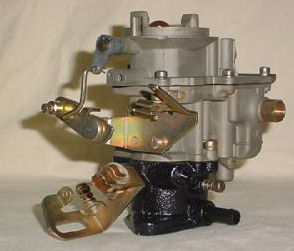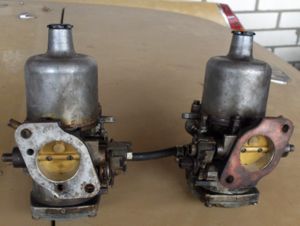Fuel Injection comes of age
The last 30 years have produced a complete turnover in vehicle
technology as today's automotive components have little in common with
their primitive ancestors. Drum brakes have been replaced by disc
brakes, solid-axle rear suspensions have given way to independent
designs, and ignition systems are now electronic rather than mechanical.
Yet of all these advances, none are as compelling as the shift from
carburetion to
fuel injection.

Certainly the use of fuel injection has been around for more than 30
years, but only since the mid-1980s has it became a widespread feature
on almost every vehicle sold in Australia. Driven by a need for cleaner
emissions, car manufacturers were forced to give up the less-expensive
carburettor for the more-sophisticated computer-controlled electronic
fuel injection, or EFI. As a bonus, they also got better performance and
improved fuel economy.
So what is it about EFI that makes it so much better than the simpler,
less-expensive, and easier-to-work-on carburettor? In a word: precision.
Through the use of sensors, injectors, and computer control, EFI
provides a far more precise fuel/air mixture under a much broader range
of operating conditions.
We know that computers play a major role in just about every aspect of
human existence. Besides supplying information for Web surfers and
entertaining games for kids (and adults), they also control most of what
goes on in today's cars. You may have heard that the average new car
possesses more computing power than the entire lunar module used to land
the first astronauts on the moon. Much of this processing power is
necessary in a modern fuel-injection system.
The computer at work under your bonnet is often referred to as the
engine controller or engine management system (EMS). It monitors
everything from barometric pressure to ambient temperature to throttle
position, in order to determine just how much fuel your engine needs. By
constantly monitoring the conditions under which the engine is running,
the EMS is able to make infinite adjustments for maximum efficiency and
performance. The EMS performs this task not only by adjusting fuel
delivery but by altering the ignition timing as well. Certain forms of
variable valve timing also use computer control to deliver peak
performance.
However, the computer is only as capable as the information supplied to
it. To keep the EMS properly informed, a number of sensors are utilized
for monitoring purposes. The three basic sensors required by every EFI
system are an RPM sensor, a manifold absolute-pressure sensor (MAP) or a
mass air sensor (MAS), and a throttle-position sensor. Most modern cars
use several additional sensors to monitor things such as barometric
pressure (for altitude changes), exhaust gases (for emission reduction),
and temperature (for a proper mixture when an engine changes from cold
to hot).
If one or more of these sensors fail, engine
performance will suffer or stop altogether. Sensor failure is a common
cause of reduced horsepower or mileage, especially on made after the
1980s when domestic fuel injection was in its infancy.
The information gathered by the various EFI sensors determines exactly
how much fuel is necessary. The engine controller uses this information
to adjust for conditions ranging from idling to accelerating to highway
cruising. A device, called the fuel injector, delivers this precise
amount of fuel into the combustion chamber through a small plunger
located in the nozzle of the injector. Since the plunger can open and
shut very quickly, it makes the injector extremely accurate at
modulating fuel flow and allows fuel injection to adjust for both small
and large variations in the operating conditions.
EFI's accuracy is based not only on the amount of time the plunger stays
open (called a pulse width) but also on the fuel pressure within a
fuel-injection system. This makes the fuel pump a much more crucial
element and explains why most modern fuel pumps are electric rather than
mechanical.
It's obvious that EFI makes for a great technical
discussion, but in rreality, is it all that much better than a
carburettor? The one word answer is YES! While you're driving your
engine is in a constant state of change. In addition to the
accelerating, braking, coasting, or idling that comes with stop-and-go
traffic, there's plenty of variation going on when coasting down a hill
with the cruise control set. You may be going up a mountain or
descending into a valley. Maybe you're on a flat plane, but the sun has
just set and the temperature is dropping.
The point is that only EFI, with its computer-based control module, can
effectively keep up with the many changes our vehicles experience on a
typical drive. Carburettors are mechanical devices that depend on
springs, rods, and engine vacuum to modulate fuel delivery. They can't
accommodate for variations between individual cylinders, inconsistent
octane, or altitude changes.



